Lucas Oil Raceway partnered with students in Dr. Pierce’s senior-level, sport management capstone class. Taking a human-centered design approach, students were tasked with enhancing the weekend race experience for drivers and families competing in racing events at Lucas Oil Raceway, predominantly designing for the “weekend warrior.”
Driving innovation at Lucas Oil Raceway
Human-centered Design
Students visited the track each weekend in September and October. Students collected data through the contextual inquiry methods of observation and ethnographic interviews. Students synthesized the data to frame problems and ideate solutions. Students completed the following problem framing exercises:
- Empathy maps
- What - how - why
- Journey maps
- Problem tree analysis
- Statement starters
- Problem stories
After framing the problem, students engaged in ideation sessions to starting creating innovative solutions to the problem. Students completed the following ideation exercises:
- Brainstorming
- Alternate worlds
- Impact difficulty matrix
- Concept posters
After developing 24 concepts, students engaged in participatory research at Lucas Oil Raceway to gain feedback from weekend warriors using the Buy Feature scorecard. Based on the notion that price measures value, (think real estate: the house is only worth what someone will pay for it), the game is designed to help elicit the truth about what people value, not just what they say they value. Using fake money and a game board, students gave participants $1,200 to spend 24 features priced at $100, $300, or $500. Users placed their money on the features they would most like to see at Lucas Oil Raceway.
This method uses a system of constraints that create tension by offering choices that exceed available resources. It simulates the conditions that exist when people have to budget their resources to get what they truly desire. Because users were provided with a limited amount of currency with which to buy items, they have to pick and choose which are most important. The results informed the development of the solutions presented by students.
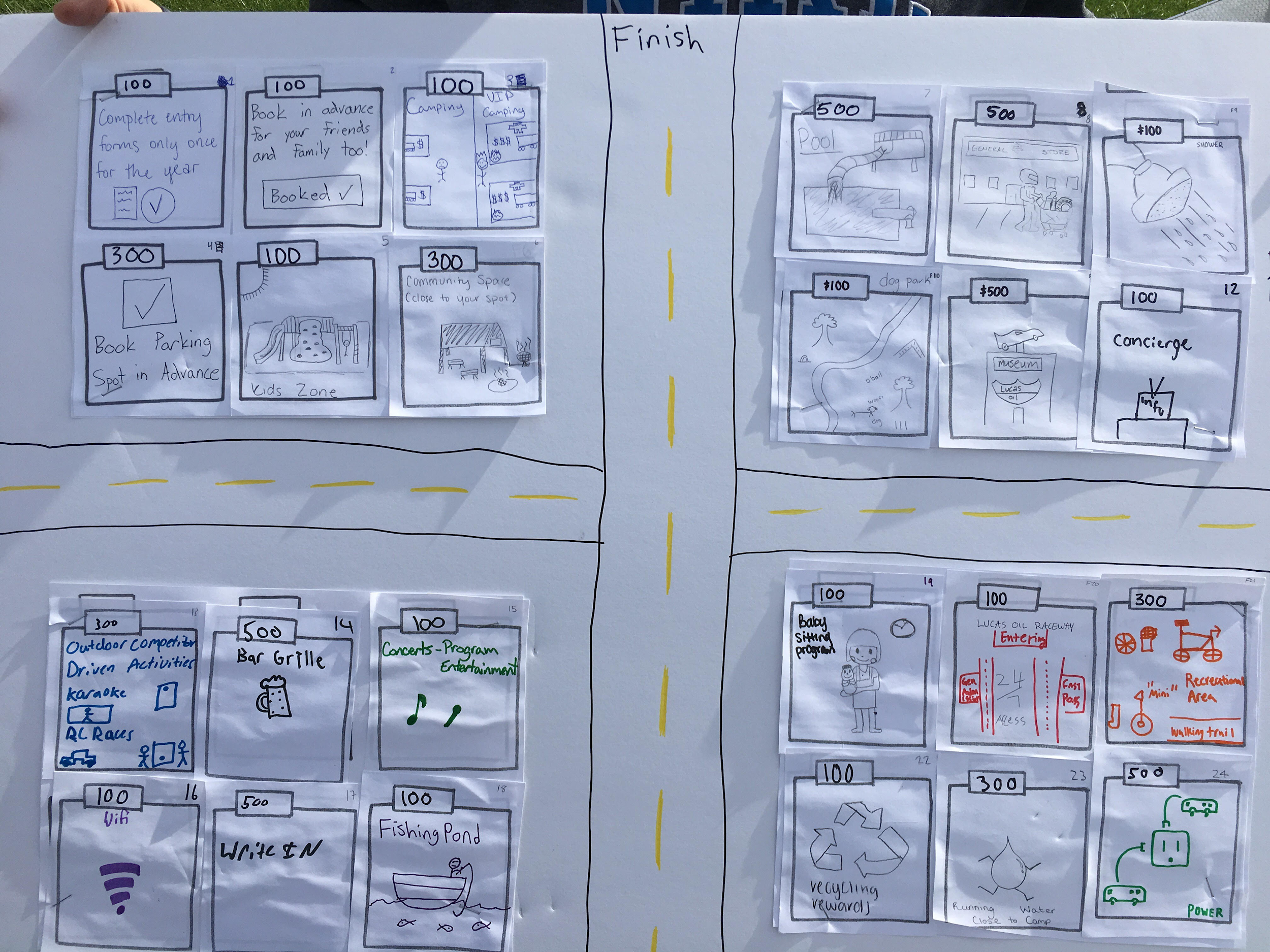
Students completed participatory research with Weekend Warriors by having them play the “Buy A Feature Game”
The Solutions
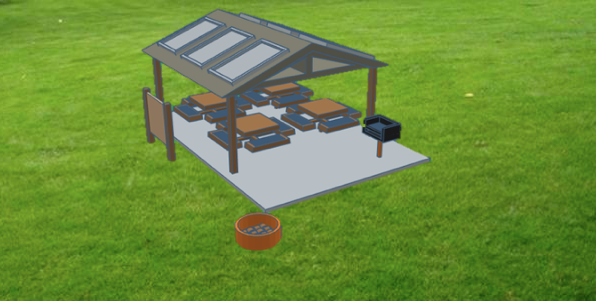
Social Hot Spots
The Social Hot Spots are 20’x20’ pavilions on a 20’x28’ concrete foundation that includes electric, picnic tables, a fire pit, and a grill. These pavilions were designed to meet the needs of the weekend warrior. The pavilions provide comfortability and convenience. These Social Hot Spots provide a nice place to be shaded from the sun in between races and easy access to a grill, picnic tables, and a fire pit. 40 people will be able to comfortably gather around these spaces, fully meeting Stacy’s needs. These spaces will be strategically placed throughout LOR to allow everyone to utilize these pavilions. After the implementation of the Social Hot Spots, racers will receive a whole new experience when they comes to the track.
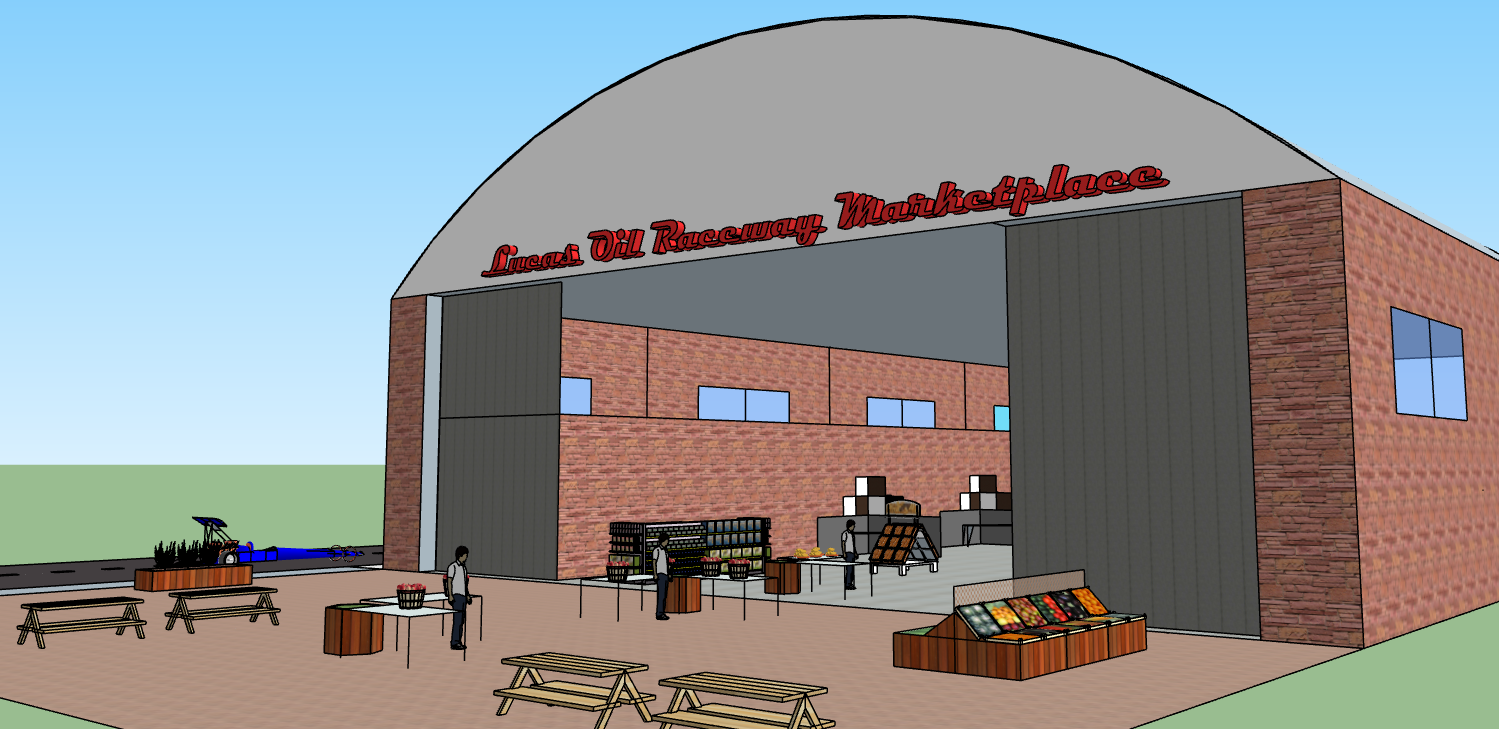
Marketplace
The Lucas Oil Marketplace provides an interactive meeting place with the convenience of one off and daily essentials. With race weekends being very busy and the potential to forget basic needs throughout the weekend, this is the perfect one stop shop instead of having to leave the grounds. This marketplace will provide an experience to not just the weekend warriors, but to racing fans in general with the multipurpose flex space that the hangar offers. Outside of the convenience created by the marketplace, it forms an environment that a multitude of consumers can call home. This hangar will aid in keeping consumers money inside the facility rather than adventuring to an off-site location. Even in the offseason this space is able to be utilized in order to make more of a profit.
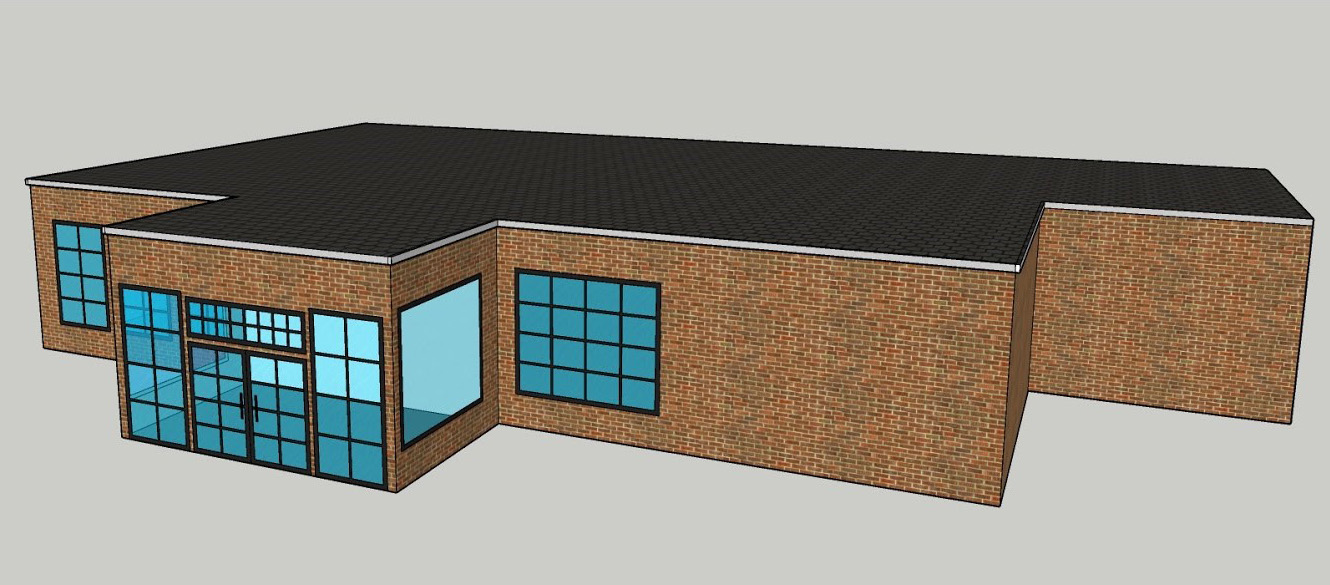
The Pit Stop
This facility is made for the fans and participants who need a break from working on their car in the scorching heat. A place where they can enjoy an ice cold drink in an air conditioned building. The Pit Stop is a restaurant that serves a variety of food choices outside of the already available concession stands. It allows for family and friends to gather and socialize in an environment that is racing oriented. With the décor being Lucas Oil Raceway themed, all attendees can learn a little more about the facility they come to every year and make their experience all that more memorable. After spending all day racing and working hard, The Pit Stop provides games on site such as corn hole and bocce ball to give people fun activities to participate in, a stage for live music, and an outdoor patio to allow everyone to relax outside of the races.
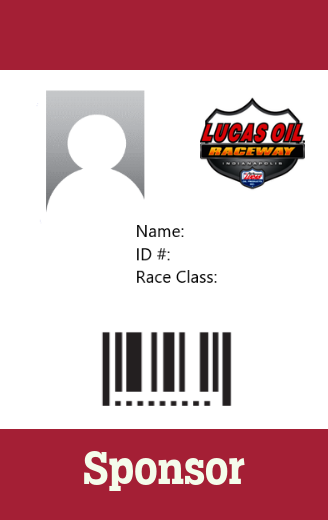
Drag Tag
One of the biggest problems that Lucas Oil Raceway is facing is their poor arrival process for the drivers. When drivers get to the raceway, they must fill out a registration form that is known as a “tech card.” The tech cards consist of personal information that the drivers must fill out every time they come to Lucas Oil Raceway for an event. After that, the drivers will wait for an Extended Technical Inspection (ETI). Finally, the drivers then must go to a separate area to sign a waiver/release form for the event. All these steps can be pain points for the drivers, as it is slow and tedious for them. Drivers have a desire and need for convenience to the raceway, and that is what the Drag Tag will fulfill. The Drag Tag is a smart id card that will provide ultimate convenience to the drivers when they arrive at the facility. Once the driver arrives at Lucas Oil Raceway, they will pull up to the ticket booth where ticket officer scans the Drag Tag. This will pull up the waiver/release form as a first step and as drivers sign the waiver, ticket officer will be able to see the personal information and race records in the NHRA. The Drag Tag will eliminate the need for the tech cards and will provide a smoother arrival process for both the drivers and staff.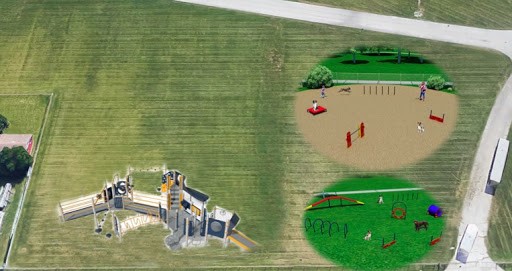
Kids and K9s
Families have downtime in between races and are usually confined to their campsite. We observed there were many pets inside the RVs, and many kids focused on their phones and technology. Families have to think twice before coming to Lucas Oil Raceway with kids and pets. Sometimes parents would come to the track and leave their kids with a babysitter and their pets at a kennel. When they did bring their kids and pets though, pets had little to no room to run around and kids were usually bored as soon as they got there as there were no activities for them to do. Kids & K9s is a playground and dog park that will let kids have somewhere to hang out at the track and it will allow dogs to roam freely. The playground is ADA accessible and the dog park is a fenced-in play park for both small dogs and big dogs to release all their energy. Kids & K9s will allow families to not worry about leaving their kids with a babysitter or their pet at the kennel. It will not only save them money, but it will make it a no brainer to visit the beautiful and historic track for a race weekend.
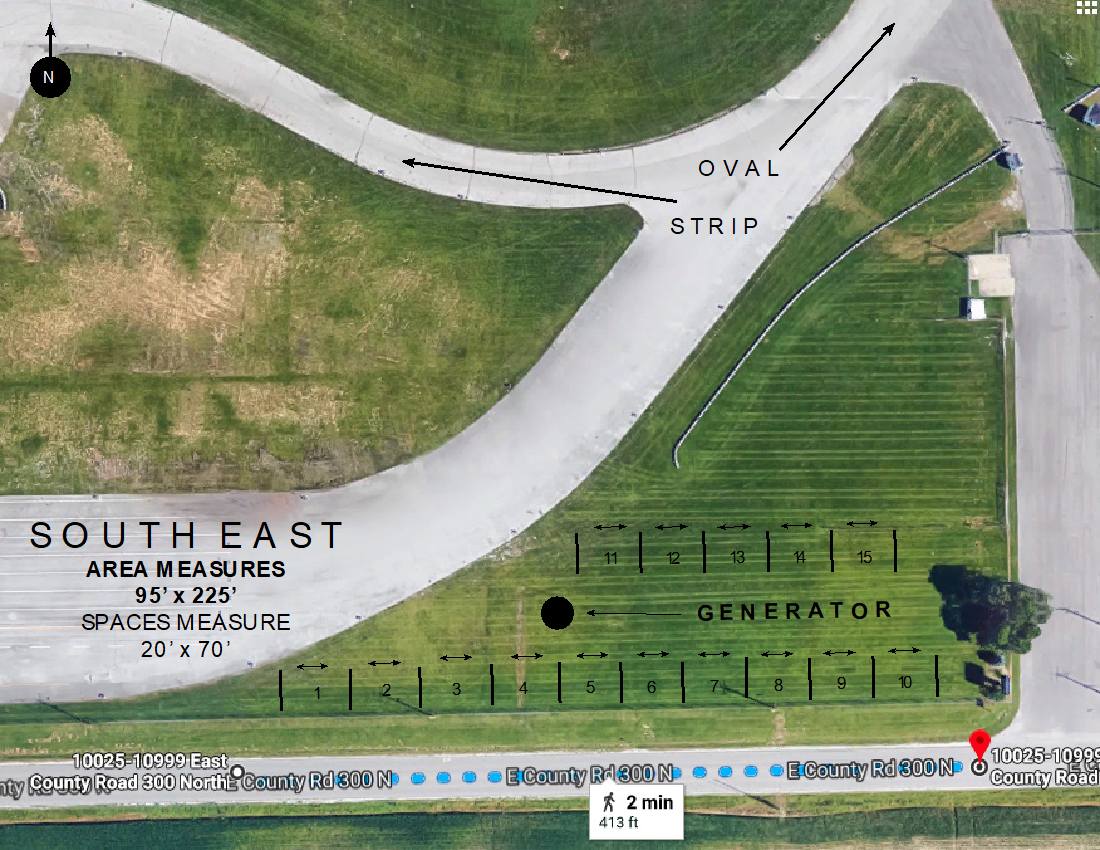
Power
While conducting research at Lucas Oil Raceway, we realized there was no power available to attendees that were camping overnight. Attendees are required to bring their own generator or forage for it onsite. Many attendees struggled with having generators that couldn’t provide them with the power they needed for the weekend which meant that they would have to make trips offsite to refill the generator with gas. Due to the lack of power, many attendees have started spending extra money to stay at a hotel a few miles outside of the facility. We wanted to remove the hazard of extension cords running to and from buildings and across busy roads as well as the inconvenience and hassle of attendees and racers bringing their own generator. All of this combined could help create a brand new revenue stream that Lucas Oil Raceway has previously been missing out on. Our idea of implementing power was to purchase one or two 100 KW generators from Winco Inc. Buying one in the beginning is more than viable, but buying two would be ideal for a higher return on investment, as well as creating more spots for our service on the premise. This newly implemented power will make Lucas Oil Raceway a top destination for every racer, even those without a generator.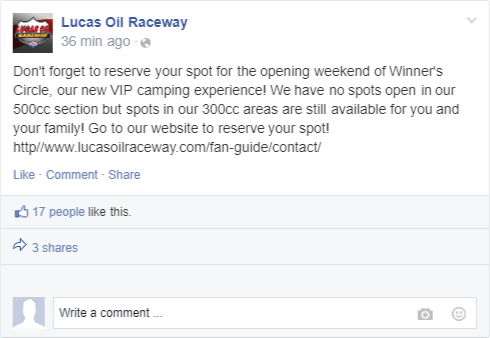
The Winner's Circle -- VIP Camping
The spots in Winner’s Circle measure at 60ftx30ft allowing for plenty of space for families to enjoy their camping experience. Amenities present in Winner’s Circle include a fire pit, picnic table, concierge service, help hotline, shower/restroom facility, and Wifi. A generator hookup will also be provided to eight spots in Winner’s Circle and will be labeled the “500cc” section while the other thirty-two spots will be labeled the “300cc” section.

